Whole-home powering, also referred to as wye-configuration power is the process of electrically connecting your entire house together through one main power source. This means that all electrical components in a home are wired directly to each other.
The obvious advantage of this setup is that if there is an outage, you have enough juice to see you through the emergency.
Apart from providing you with power during an outage, whole-home powering can also be used to lower your energy consumption. A main breaker in the panel is connected to a specially built transfer switch that will enable you to select which parts of the house require an uninterrupted power supply during an outage and which parts can go without it for the time being.
A whole house generator also known as standby generator (unit) or backup power supply is an appliance that provides electrical power to a residence during outage. It can be installed near gas tanks and water source for easy connection, many of them also have wheels installed so it can easily move from place to place.
The generator set consists of an engine, a mechanical device like alternator or hydraulic pump, fuel storage tank(s), and control unit (circuit breaker). Most units feature automatic transfer switches which offers increased safety over conventional manual switches. This type of generator is most commonly found in homes and businesses where utility power is not always available or desired, for example on vacation property, remote construction sites and more.
Some people call it as portable generator but the fact is that they are actually different because a portable generator has wheels installed so it can easily move from place to place while whole house generators don’t have any wheels at all.
Best 5 Whole House Generator Models Reviewed
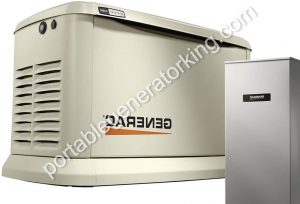
The Generac 7043 inverter generator comes with a NEMA 3 rated (indoor and outdoor) whole-house Smart transfer switch and the ProVision True Power technology which delivers less than 5% THD for smoother operation of sensitive electronics.
Electronics such as computers, printers, appliances that are important to us all work well in this environment. The controller is available with LED indicators that tell you the generator status, utility power presence or maintenance required. This generator has a tough durable exterior made out of aluminum material and three removable side panels for starter installation service giving better access to work on your generator through the summer months while it is outside since no battery left inside today when sold.
This generator has a low oil shutdown system built in at the factory and is fully automatic as well to keep the engine operating at its optimal efficiency. Its fuel-efficient plus propane is ready for only $200 extra cost for owner’s manual, including 2-year warranty parts and labor – it also needs greasing every 100 hours of use or annually. This machine comes with wheels so that you can roll it easily into position during an emergency.
The Generac 7043 features a quiet rating of 57 DB when the Smart Switch technology is engaged which is not bad but still loud enough to notice if you are outside the house where this whole-house solution is located. It weighs about 700 pounds dry when empty so think ahead on how your going to get it your home when you are buying this unit as it needs to be installed by an electrician before the power goes out. You can start this generator manually if needed, but you’ll need to buy a battery or battery charger separately for about $200 extra cost and install it in the system yourself via your carry-on kit.
One potential problem is that Generac no longer handles its own Consumer Protection coverages which means that you’ll have to contact Green Leaf Power (a sister entity) directly for all issues.
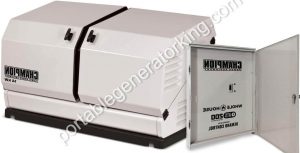
The Champion Power Equipment 100294 is a very strong, low-maintenance generator especially for homeowners who live in remote areas. Supportive of the Smart Switch technology it comes with a NEMA 4 rated (indoor and outdoor) whole-house transfer switch and the ProVision True Power technology to deliver less than 5% THD for smoother operation of sensitive electronics.
The generator is also by the way EPA certified for noise level with a rating at 57 dBa (decibels above A) on low speed /42 dBa on high speeds which is quite loud and might be noticed from inside of your house if placed next to it, especially during starting mechanisms. Generators can cause vibrations that can damage your house and this is especially true for concrete slab foundations.
Champion Power Equipment can handle up to two-thousand watts of electrical demand at one time with a surge capacity of ten thousand watts as well. The 100294 features automatic load leveling (automatic voltage regulation), comprehensive diagnostics, an inverter design and a noise rating of 57 dB a on low speed / 42 dBa at full load.
The machine features a 120-volt input with an output of 110 V for use in most locations. It includes handles, wheels and fuel tank capacities of 1 gallon for moving the unit into position when need be.
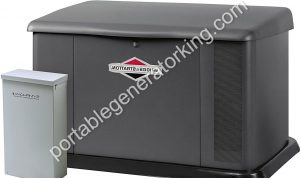
The Briggs & Stratton Power Products 40555 generator is built for long-term operations with an EPA Tier 4 engine that is much quieter than traditional generators and a vanguard engine that reduces harmful fuel emissions. The included 200 amp of the Symphony II automatic transfer switch lets you power all the circuits in your home without requiring a subpanel. You don’t have to worry about cut offs or downtime when running this mega wattage generator, designed here inside the USA with BRIGGS AND STRATTON VANGUARD ENGINE at its core.
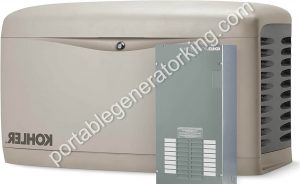
This 20,000-watt air-cooled generator automatically starts up when the power goes out. This Kohler model features a 100 amp 16-circuit automatic transfer switch, fast response – power to your home in 10 seconds; premium power quality; and quiet operation. The corrosion-proof enclosure offers protection from even the harshest seaside conditions, while measures 48 by 26.2 by 29 inches so it will fit almost anywhere for an unnoticeable addition to your landscape. We’re confident that this product is of superior value and are prepared to provide you with some friendly advice on why we feel that way! Stop worrying about feeding your family next time there’s a brownout–choose this trusted standby unit now and never have to worry about running out of power again.
The Kohler 20RESCL-100LC16 inverter generator comes with a quiet engine design which lets you run it indoors without disturbing the neighbors or sacrificing your own comfort level. An idle control function automatically adjusts load to keep the engine from idling for longer than necessary, helping to extend the life of the motor. The generator’s fuel tank has been designed to be corrosion resistant, helping to prevent leaks and spills inside your garage or storage area.
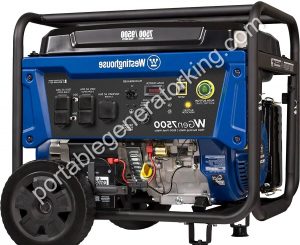
Introducing the Westinghouse WGen7500 Portable Generator, an ultra-quiet and powerful portable generator with a 9,500 peak watt capacity. Easily power tools, grills, refrigerators, televisions…whatever you need for up to 11 hours from an easy-to-fuel 6.6 gallon tank on one of two starting options – electric or recoil! You’ll get more than enough juice for all your needs thanks to a 7,500 running watts capacity and 420cc 4 stroke OHV engine. Bulletproof reliability like this is hard to find at any price point so take advantage now before we sell out or give us a call if you have questions!
When you need a backup power supply, look no further than the WGen7500 Portable Generator from Westinghouse. Boasting an ultra-quiet engine design, this generator is ideal for indoor use and giving you peace of mind that you won’t disturb your family or neighbors. You’ll also love how easy it is to fuel this portable unit as the 6.6 gallon tank can be filled with either a standard gas/oil mixture or 100% gasoline for easy starting no matter what conditions you are facing!
How To Choose The Best Whole House Generator
The choice of a whole house generator is pretty much the same as for any other power source.
Gasoline generators are more expensive but they also tend to last longer and perform better in emergency situations. If you plan on using your generator only during emergencies then gasoline will do equally well. The only problem with gasoline is that it has a shorter shelf life because of its volatile nature, so if you’d like your generator to be accessible at all times, keep that in mind when choosing gasoline.
Besides fuel type and availability there are other factors to consider when choosing your whole-house solution: size, quality, operation costs and warranty.
Size is important because there are limitations as to how much power a generator can continuously supply. Most generators come in different sizes with the largest units able to produce anywhere from 12,000 to 22,000 watts. The reason you’d go for a larger unit is if you plan on powering a lot of appliances at once or even an entire house. You should also look into fuel efficiency as well as what sort of noise level are you comfortable with.
Portable units can provide enough juice for smaller things like fridges but if you have several of these along with other appliances, then it’s best to go for a unit that has more capacity than what’s necessary – 5 kVA should do the trick. If you are going an a standby generator, bigger is better and make sure to go for something that’s at least 10 kVA.
On the other hand, if you’re looking for whole of the portable generators-house alternatives, then there is no universal answer because it all depends on how much power your electrical grid needs for keeping everything running smoothly. If it doesn’t exceed 7500-8000 watts, then should be able to get by with something 8 or 10 kVA model.
According to electric generator experts, running times can be estimated by dividing the rated wattage (in kilowatts) by 10.
If you plan on using it for eight hours a day then you’ll need at least an 8kW generator and so on. You’ll also want to look into the fuel efficiency of any given model which is measured in gallons per hour, multiply that number by 30 if it will run for 30 days straight. That will give you an approximate estimate of how much gasoline you’ll go through.
High quality is another factor that directly affects the safety and reliability of your system. Your whole house should be powered by a generator with the highest possible efficiency rating, so look for one that meets UL (Underwriters Laboratories) standards. It will also pay off in terms of longevity and durability if you opt for high-end materials like stainless steel or cast iron instead of the cheap plastic parts most units have.
Operation costs refer to initial cost plus running cost per hour of operation. The higher these costs the more expensive it will be to power your house. Almost all models cost the same to run per hour, so if you don’t plan on using it much, a cheaper model will be a good buy.
Warranty is also an important factor to consider. Your whole-house generator should come with at least 5 years of warranty in order for you to be able to enjoy it for years without having to worry about its performance.
Frequently Asked Questions
Conclusion
You can keep your home and family safe from power outages indefinitely with the use of standby generators. There are many models to choose from when it comes down to size, capacity, fuel supply sources, control systems and more which means that you’ll want to carefully research what’s available before making a final decision on where to go. If you’re serious about the best results then there’s no substitution for professional guidance which is necessary in order to pick out the most efficient unit for your needs. Be sure to gain comprehensive knowledge on the subject by reading reviews written by industry experts who have put their years of experience into writing detailed reviews that will save you time and money in the long run. You’ll be able to see all aspects of a generator including power output, fuel type, control systems and much more which will help you to make the best decision for your home or business.